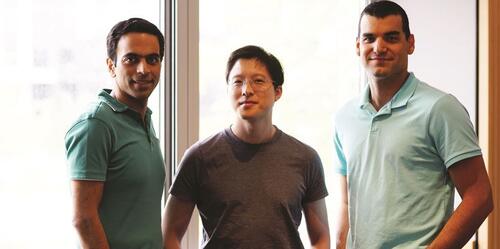
Non-invasive technology promises to reduce biopsies
Elucid Labs uses AI in imaging device to detect skin cancer

Elucid Labs uses AI in imaging device to detect skin cancer
A medical startup has developed cutting-edge imaging technology that has the potential to detect skin cancer without leaving a mark.
Elucid Labs uses artificial intelligence (AI) technology in a small non-invasive imaging device to analyze moles and other skin lesions for signs of skin cancer, helping dermatologists make faster, more accurate decisions and reducing the number of unnecessary biopsies.

From left to right, the cofounders of Elucid Labs: Iman Khodadad (PhD '17), Alexander Wong (BASc '05; MASc '07; PhD '10), and Farnoud Kazemzadeh (BSC '08; MASc '12; PhD '16).
The company, named one of the 20 most innovative technology companies for 2017 by the Canadian Innovation Exchange, was co-founded by Alexander Wong, a Waterloo systems design engineering professor, and Iman Khodadad and Farnoud Kazemzadeh, who both earned their engineering doctorates at Waterloo.
“Our vision is to eventually replace all biopsies whether they’re skin related or internal, having anything to do with cancer or any other disease,” says Kazemzadeh.
Elucid Labs spun out of the research Kazemzadeh conducted for his PhD that was inspired by his background in both astronomy and engineering– his undergraduate degree from Waterloo is in astronomy and astrophysics and his master’s degree, which is also from Waterloo, focused on laser and optical engineering. He took what he learned from all his degrees and applied it to biomedical engineering.
“I figured out that the same way I looked at a star to find out what was going on inside of it, including its temperature, pressure, chemical makeup and magnetic field, I could do looking at a person,” he explains. “I want to make a difference here on earth.”
The new technology Kazemzadeh describes as being able to “see through the skin” will benefit everyone, but particularly people on medications such as blood thinners who could suffer medical problems by undergoing an invasive biopsy.
The device will also save money. Kazemzadeh estimates that the cost per scan could eventually be less than $50, which is considerably less than the average price of a biopsy conducted today. And the technology is designed to be portable and used in remote areas that don’t have medical professionals nearby.
“This is like a dermatologist in a box,” Kazemzadeh says. “You can at least get the basics of dermatology in a community that doesn’t have access to the specialist.”
Located in Waterloo’s Velocity space with an office location in Mississauga, Elucid Labs has received funding from Waterloo Engineering and from the University’s Velocity program.
The company recently conducted a few pre-clinical trials to gather user comments. The results of the trials have been published in medical journals to expose the community to its technology.
“The general feedback from the doctors has been extremely positive as they are starting to see how this technology could help them perform their duties faster and better,” says Kazemzadeh. “We have been able to explore other use cases of the technology beyond dermato-oncology.”
Kazemzadeh, now a Waterloo Engineering adjunct professor, anticipates it will be an uphill battle to change a practice that has been in its current form for many years and take time before the medical community completely stops performing biopsies.
“Ten years from now, we’re going to look back at today and say it was barbaric that we used to cut ourselves open to know what disease we had,” he says. ”So the digital biopsy technology is going to be realized. And we’re going to be the ones to make it happen.”

Read more
Here are the people and events behind some of this year’s most compelling Waterloo stories

Engineering master's student Nayeema Nonta (left), one of the three paper authors, and her supervisor, Dr. Sirisha Rambhatla, in a large server room with the computer power needed to develop their new LLM training technique. (University of Waterloo)
Read more
Waterloo researchers develop highly efficient AI training system that paves the way for cheaper, greener “intelligent partners”

Read more
Engineering researchers team up to tackle the plastics pollution problem with microbial innovation and engineering design
The University of Waterloo acknowledges that much of our work takes place on the traditional territory of the Neutral, Anishinaabeg, and Haudenosaunee peoples. Our main campus is situated on the Haldimand Tract, the land granted to the Six Nations that includes six miles on each side of the Grand River. Our active work toward reconciliation takes place across our campuses through research, learning, teaching, and community building, and is co-ordinated within the Office of Indigenous Relations.